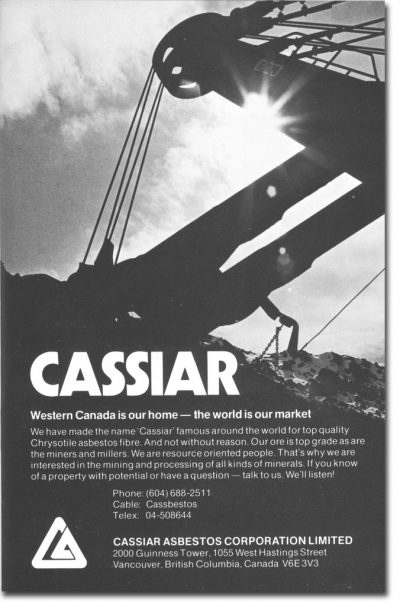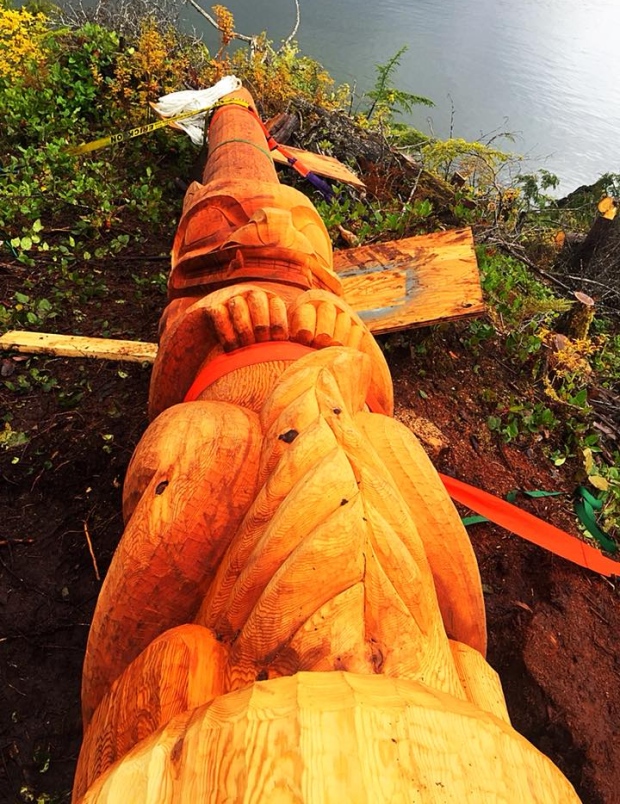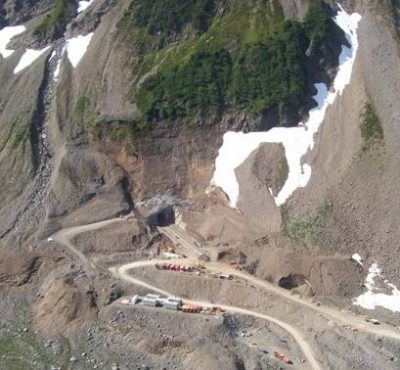#186 Industrial follies
October 23rd, 2017
REVIEW Unbuilt Environments: Tracing Postwar Development in Northwest British Columbia
Vancouver: UBC Press, 2017
$32.95 / 9780774833059
by Jonathan Peyton
Reviewed by Wade Davis
*
“In the early 1960s just getting people to stop throwing garbage out of a car window was considered a great environmental victory,” says renowned, B.C.-raised anthropologist Wade Davis. Now Jonathan Peyton’s Unbuilt Environments examines the history and social context of five industrial initiatives, all transformative in scale, that have been proposed or enacted in Northwest British Columbia, largely in the drainage of the Stikine River. Reviewing this essential and dispassionate analysis of northern B.C. mega-projects, Wade Davis concludes, from Peyton’s overview, that there is “little doubt that industrial folly conflated with corruption persists to this day… Whatever one’s views on the virtues or challenges of the energy sector of the economy, the provincial government’s failure after such fanfare to bring on line even a single LNG development, must surely leave any British Columbian both discouraged and frankly embarrassed.” – Ed.
My father came of age in the 1930s, son of a doctor in the lead zinc mining town of Kimberly in the East Kootenays. To reach his boarding school on Vancouver Island, he would take a boat down river to Spokane, Washington, where he could catch a train west for Seattle and the coast. Such was the state of infrastructure in British Columbia at the time, an economically debilitating void that men of my father’s generation sought avidly to fill as they came back from war in 1945.
The master architect was W.A.C. Bennett, premier from 1952-72, another son of a small interior town, whose vision for the province embraced public works projects on a gargantuan scale, viewing each as an almost Biblical challenge, a triumph of personal will. As his political rival and later ally ‘Flying Phil’ Gaglardi laced the province with bridges and roads, many through lands conveniently owned by his sons, Bennett stamped his name on the largest construction project in the history of the province, one of the world’s highest earth filled dams, a $6 billion investment (in today’s dollars) that flooded 350,000 acres of forested land, displacing without consultation the entire Tsay Keh Dene First Nation, a people who have yet to recover from the blow.
 W.A.C. Bennett like most of his peers believed that any natural resource not used was wasted. Modern industrial logging took off during his tenure, driven by new machinery and technologies, and fueled by a triumphant ideology that called for the elimination of all primary forests in the province. Science, it was said, had shown that the annual increment of cellulose in a young tree plantation was greater than that of an ancient forest. The old growth was, by definition, a forest in decline. The trees were over mature. To see evidence of decadence, one had only to look at the deadfall, tons of rotting timber wasted on the forest floor. The goal of proper management was to replace these inefficient stands with fresh and productive new forests. A regime of carefully monitored clear cut logging would eliminate the old growth, the debris would be burned, and the land sown with a uniform plantation comprised of only the most up-to-date conifer seedlings. In short, scientific forestry would clean up the mess inherited from nature. If it served the economic interests of industry by rationalizing the wholesale eradication of the old growth forests of the province, so much the better.
W.A.C. Bennett like most of his peers believed that any natural resource not used was wasted. Modern industrial logging took off during his tenure, driven by new machinery and technologies, and fueled by a triumphant ideology that called for the elimination of all primary forests in the province. Science, it was said, had shown that the annual increment of cellulose in a young tree plantation was greater than that of an ancient forest. The old growth was, by definition, a forest in decline. The trees were over mature. To see evidence of decadence, one had only to look at the deadfall, tons of rotting timber wasted on the forest floor. The goal of proper management was to replace these inefficient stands with fresh and productive new forests. A regime of carefully monitored clear cut logging would eliminate the old growth, the debris would be burned, and the land sown with a uniform plantation comprised of only the most up-to-date conifer seedlings. In short, scientific forestry would clean up the mess inherited from nature. If it served the economic interests of industry by rationalizing the wholesale eradication of the old growth forests of the province, so much the better.
Men like my father shared W.A.C. Bennett’s frontier values, honed by the Great Depression, forged years before the word ecology, let alone biodiversity, sustainability, biosphere or climate change, had entered our vocabulary. In the early 1960s just getting people to stop throwing garbage out of a car window was considered a great environmental victory. To look back at that era is not to judge, but merely to suggest that we live in a completely different time, and to allow those values of the past to determine public policy today is as inappropriate as anchoring our future in the convictions of 19th century clergymen who claimed with absolute certainty that the Earth was but 6000 years old.
And yet, as Jonathan Peyton reveals in his insightful book, Unbuilt Environments, this is precisely what we’ve done and what we continue to do throughout the northern reaches of the province. That federal and provincial governments have squandered hundreds of millions of dollars on unrealized mega-development schemes may come as a surprise to urban Canadians, for much as we like the idea of the north, few of us ever go there. Gordon Campbell in his decade as premier, and indeed in his entire life, never once visited the northwest quadrant of British Columbia, even as his government funded and endorsed industrial initiatives that promised to fundamentally transform the region. Jonathan Peyton, by contrast, has traveled extensively throughout the north, and his comprehensive analysis resonates with authenticity.
Unbuilt Environments examines the history and social context of five industrial initiatives, all transformative in scale, that have been proposed or enacted in Northwest British Columbia, largely in the drainage of the Stikine River. Traditional territory of the Tahltan First Nation, the Stikine is roughly the size of Switzerland. It’s the kind of place Canada could toss England and the English would never find it.
 The first of these projects, and the only one to come on line and reach the end of its life, is Cassiar Asbestos, which declared bankruptcy just before shutting down in 1992. For 40 years before that the mine thrived as the one industrial magnet for infrastructure development and employment in a region the size of Oregon.
The first of these projects, and the only one to come on line and reach the end of its life, is Cassiar Asbestos, which declared bankruptcy just before shutting down in 1992. For 40 years before that the mine thrived as the one industrial magnet for infrastructure development and employment in a region the size of Oregon.
A company town of 1200, Cassiar attracted workers by offering easy access to home ownership, and supporting an active civic culture along with all the facilities of a regular town, a movie theatre, two churches and two schools, a small hospital, ski hill and curling rink, library and recreation center. The Lion’s Club and PTA met regularly in a company hall where also gathered members of the handicraft, bridge, badminton and gun clubs. There were hockey teams and choirs, boy scouts and girl guides.
When the mine closed, every structure was dismantled or moved. Those who had made a home there, some for generations, simply scattered to the wind. Today, Cassiar is a ghost town of fading memories. All that remains is a mountain of toxic tailings, 16 million tons altogether.
*
Unbuilt Environments goes on to discuss two mega projects from the 1970s which, in the words of northern filmmaker Monty Bassett, collapsed under the weight of their own stupidity.
In 1969, BC Rail decided to extend the provincial railway some 540 kilometers from Fort St. James northwest to Dease Lake, an arbitrary destination that consisted at the time of just a handful of broken down structures once owned by the Hudson Bay Company. The rationale in part was to open up the country for resource extraction, notably the extensive anthracite deposits underlying the headwaters of the Skeena, Stikine and Nass rivers, a region known today as the Sacred Headwaters.
Construction of the Dease Lake extension began in 1970, but costs soon soared to $360 million, five times the original estimate ($1.5 billion today). When in 1977 amidst considerable controversy the project was abandoned, the rail grade reached as far as Dease Lake, but only the first 84 kilometers at the southern end were operational. A Royal Commission established to review the project revealed not only massive cost overruns, but also shoddy construction from one end of the line to the other, a consequence in part of W.A.C. Bennett’s imposed mandate to build the project at “minimum cost/maximum speed.” Today the grade, locally dubbed the railroad to nowhere, serves as the most expensive back country mountain bike trail in the world.
Even as the government struggled with the political fallout of the collapse of the Dease Lake extension, BC Hydro, then a Crown Corporation, was gearing up to build a massive hydroelectric development in the canyons of the Iskut and Stikine rivers. Three dams were planned for the Iskut, and two on the Stikine, including Site Zed, a concrete arch dam projected to soar as high as a 75-story building. Together the Stikine dams were expected to completely inundate Canada’s largest and most dramatic canyon, destroying a stretch of wild river known throughout the world as the K2 of white water challenges. The cost of the project was a staggering $7.6 billion, ($46 billion in 2017 dollars) making it the biggest capital project ever conceived by BC Hydro.
By project design the Site Zed reservoir would reach up the Stikine and drown the new railway bridge that had only just been completed at considerable expense as part of the BC Rail Dease Lake extension, an indication of just how little coordination occurred between government entities responsible for these enormous industrial projects.
Despite BC Hydro’s dire predictions that without the Stikine/Iskut dams the province would face severe shortages of electricity, the project stalled, though not before tens of millions of dollars had been spent. What saved the canyon was both strong local opposition from the Tahltan and a fortuitous shift in the corporate culture at BC Hydro that resulted in a new public focus on efficiency and conservation. The power shortages long anticipated by proponents of the dams never materialized.
The final two case studies in the book- the story of Dome Petroleum and the dream of an LNG economy, followed by the saga of the Northwest Transmission Line, the ‘powerline to nowhere’- leave little doubt that industrial folly conflated with corruption persists to this day. Indeed, one comes away from Peyton’s dispassionate analysis wondering what if anything has been learned from the costly debacles of the 1970s, even as one asks how and why we continue to elect politicians cut from the same ethical cloth as ‘Flying Phil’ Gaglardi.
Whatever one’s views on the virtues or challenges of the energy sector of the economy, the provincial government’s failure after such fanfare to bring on line even a single LNG development, must surely leave any British Columbian both discouraged and frankly embarrassed.
For more than a decade I served on the International Advisory Board for Peru LNG, a US$3.8 billion project led by Hunt Oil, the world’s largest privately held energy company. Investing tens of millions in environmental mitigation, the consortium built an exemplary 400-km pipeline across the Andes, and at the coastal terminus at Pampa Melchorita an equally impressive port and LNG facility capable of processing 620 million cubic feet of gas a day.
As a consultant with oversight responsibilities, ultimately reporting to the multilateral banks that funded the project, I was privy to internal discussions and experienced what it actually means to bring such a project on stream, both the costs, the scale of the enterprise, the challenge of international markets. Ours was the first LNG plant ever constructed in South America, and the race to get it built was informed by a sense that given market demands there might not be room for more than one or two such export facilities in all the Americas.
When I later learned that in British Columbia Premier Christy Clark claimed to be considering no fewer than 20 proposals, all calling for separate export facilities, even while anticipating $1 trillion in revenue and promising to add 100,000 permanent jobs to the provincial economy, I assumed that those at the helm of our government were either dishonest or had no idea what they were talking about. One dreaded the former, and feared the latter. Jonathan Peyton, I suspect, knows the truth though he is hesitant to say.
Of the five major projects examined in Unbuilt Environments, the most compelling and disturbing story is the last, and it concerns an initiative that on the face of it ought to be the least controversial, the extension of the provincial power grid through the construction of the 344-kilometer 287 kilovolt, Northwest Transmission Line (NTL) from Terrace to Bob Quinn Lake.
In 2008 the Mining Association of BC released an industry survey estimating that $15 billion in new capital investment leading to 10,000 full-time jobs might be generated if only power on an industrial scale could be delivered to the mineral rich northwest quadrant of the province. Premier Gordon Campbell immediately set aside $10 million to kick-start the environmental assessment.
Rationalizing the costs of the investment, initially budgeted at $400 million, were a series of large industrial projects in different stages of development, all promising and all in Tahltan territory. These included Imperial Metals’ open pit copper and gold proposal on Todagin Mountain, two similar mines at Galore Creek and Shaft Creek, a run of the river hydro project at Forest Kerr canyon, Shell’s million-acre coalbed methane tenure in the Klappan, and Fortune Minerals anthracite claim, also in the Klappan.
Even as the premier launched the initiative, Byng Giraud, then vice-president of the Mining Association of B.C, cautioned that all these “big-ticket items were more a wish list than anything certain”, adding that “nobody should necessarily go to the bank on this.” Unfortunately, someone did, the British Columbian taxpayer, although they didn’t know it at the time.
Within two years the cost of the NTL had increased by half; eventually it would come in at $736 million. In addition, BC Hydro committed to reimburse Imperial Metals $52 million for the costs of building their dedicated line from Bob Quinn to the Red Chris mine site on Todagin Mountain, as well as the costs of a smaller line north to the Tahltan community of Iskut.
Of this $736 million, Alta Gas, owner of the Forrest Kerr project, would by agreement pay $180 million. In Ottawa, the Harper government agreed to invest $130 million the Green Infrastructure Fund, money set aside according to the government website, to support “projects that will improve the quality of the environment and…that promote cleaner air, reduced greenhouse gas emissions and cleaner water.” The official rational for the inclusion of the $130 million was the Ottawa’s desire to get 350 Tahltan at the small community of Iskut off of diesel generation to reduce their carbon footprint, albeit at a per resident cost of close to $400,000.*. Even with this questionable federal subsidy, BC taxpayers remained on the hook for at least $478 million.
For the provincial government things began to unravel just as construction of the NWT was coming to an end. In 2012 Shell withdrew from its coal bed methane development in the Klappan. The promising and highly promoted Galore Creek copper and gold project imploded due to fiscal challenges and uncertainties. Fortune Minerals, rebranded as Arctos, remained committed to its anthracite play in the Sacred Headwaters, but given Tahltan opposition, it had very weak legs, especially in the wake of the Supreme Court’s Tslihqot’in decision. AltaGas’ hydro project at Forrest Kerr was a going concern. But the public was going to be hard pressed to understand why well over $700 millions of public funds were spent to extend the provincial grid to facilitate a private power company’s efforts to sell back electricity to the state. By 2012 of the five mining projects that had rationalized the construction of the NTL back in 2008, only one remained viable, Imperial’s Red Chris mine on Todagin Mountain.
There is most assuredly nothing wrong with governments creating infrastructure that will promote economic growth or bring benefits to a wide range of citizens and diverse business interests. But things get a bit murkier when the benefits accrue exclusively to one sector of the economy. And they become downright muddy when they effectively benefit a single company, especially one owned by an individual who has heavily bankrolled the political campaigns of the government authorizing the massive public expenditure.
Here was another challenge for the government. Imperial’s Red Chris project had been kept a float by the personal investment and loan guarantees of Murray Edwards, owner of the Calgary Flames. His investment of some $200 million had effectively bought him ownership of Imperial. On the eve of the 2013 provincial election, with the Liberals behind in the polls, Edwards hosted at the Calgary Petroleum Club a private dinner for Premier Christy Clark that raised $1 million for her campaign. Nothing illegal in this, but it was hardly something to reassure the British Columbian public, given that Red Chris was the only industrial project aside from Forrest Kerr to benefit from construction of the NTL.
Yet even here the optics for the government were problematic. Todagin is home to the largest concentration of Stone sheep in the world, a resident population that attracts remarkable numbers of predators. A wildlife sanctuary in the sky, the massif looks west to Edziza, sacred mountain of the Tahltan, north to the Grand Canyon of the Stikine, and east to the Sacred headwaters, birthplace of the Stikine, Skeena and Nass Rivers, and beyond to the Spatsizi, widely recognized as the Serengeti of Canada. There are over 4000 copper properties in the world. To build an open-pit mine on Todagin was in the eyes of critics of the project like drilling for oil in the Sistine Chapel.
But consider the government’s dilemma. Some $800 million had been spent to build what was effectively a subsidized line for a single mine. At the same time the government had to have a successful mine at Red Chris to avoid accusations of having built a ‘powerline to nowhere’. In the 1970s the collapse of the Dease Lake extension of the BC Rail, the so-called ‘railroad to nowhere”, had brought down a government.
If the optics of Red Chris were already poor, public perception became truly dreadful in the wake of the Mount Polley disaster in August 2014, a catastrophic failure of the tailings dam at Imperial’s other major holding, an open pit copper and gold mine near Quesnel Lake that had been promoted by the company as the design prototype for the Red Chris development. Altogether 10 million cubic metres of industrial water and 4.5 million cubic metres of slurry tainted with heavy metals surged into one of the most celebrated salmon lakes in the world, the place of origins of fully a quarter of the Fraser River run.
As it turned out Imperial Metals had a history of operating the tailings pond beyond capacity since at least 2011. The independent investigation into the cause of the breach concluded that while the dam had failed because of an undetected weakness in the foundation, it could readily have failed by over-topping, which it almost did in May 2014. Or it could have failed by internal erosion, for which some evidence was discovered. “Clearly,” the panel concluded, “multiple failure modes were in progress, and they differed mainly in how far they had progressed down their respective failure pathways.”
The Mount Polley disaster sent shock waves through the Tahltan community at Iskut. They heard media reports that employees at Mount Polley had quit high paying jobs, because management refused to listen to their concerns about the safety and integrity of the dam. They discovered that independent consultants hired by Imperial had expressed similar concerns only to be ignored. They learned too that the insurance policies held by the company were insufficient to cover the costs of cleaning up the mess. Imperial’s insurance coverage was a mere $15 million; the clean-up of the two most recent major tailings pond failures comparable to that of Mount Polley had cost $350 million and $600 million respectively.
In the wake of Mount Polley there was a strong sense in Iskut and indeed throughout British Columbia that Red Chris would be put on hold at least until the cause of the failure at Mount Polley was fully determined and corrective measures established and implemented. In fact, quite the opposite occurred. Just six months after the disaster, and within days of the release of a report that was by every measure damning, and even as search warrants were issued allowing government investigators to comb Imperials records at Mount Polley, the Red Chris mine received an interim permit to begin processing copper and gold ore using the same wet tailings design that had failed at Mount Polley.
With the Kafkaesque logic that Imperial needed a revenue stream to cover the costs of the cleanup, the provincial government allowed Imperial to return to limited production at Mount Polley less than a year after the disaster, even as it fast tracked its final permitting process for the Red Chris mine. On June 23, 2016, the government authorized Mount Polley to return to normal operations and process up to 20,000 tons of rock per day while continuing to store wet tailings. To date, Imperial Metals has never been obliged to pay any fines, nor have any of the small family businesses on Quesnel Lake driven out of business by the disaster received any compensation from the company or the government.
Jonathan Peyton by bringing to light the history of these spasmodic industrial developments in the north has done an immense public service. His research is comprehensive, his analysis precise, his tone moderate and dispassionate. Indeed, there are moments when the reader, overwhelmed by Peyton’s revelations, the scale of the corruption, the extent of the folly, the aggregate waste of tax payers’ wealth, almost wishes for a more emotional reaction from the author. Yet the great strength of the book is its restraint, for the facts and history alone provide sufficient indictment.
For too many years politicians in all parties in British Columbia have essentially told the people of the province that the only way we can generate an economy is to tear open our land, tear down our forests and empty our seas. We are so few and we live in a place that is so vast. We are civil, decent and among the most educated citizenries in the world. Our intellectual and entrepreneurial capacity is limitless. When politicians tell us that the only way we can make a living is to compromise our natural heritage, it is not a question of a lack of economic options, but rather a dearth of imagination and moral character on the part of those we elect to office.
*
[1] Diesel generation at Iskut resulted in total CO2 emissions of 2800 tons a year. In building the right of way for the NWT BC Hydro burned the equivalent of 14,000 logging truck loads of wood, releasing an estimated 338,250 tons of CO2, the equivalent of 120 years of Iskut’s carbon production under diesel generation.
*
Wade Davis is Professor of Anthropology and the BC Leadership Chair in Cultures and Ecosystems at Risk at the University of British Columbia. Between 1999 and 2013 he served as Explorer-in-Residence at the National Geographic Society. Author of 20 books, including One River, The Wayfinders and Into the Silence, winner of the 2012 Samuel Johnson prize, he holds degrees in anthropology and biology and received his Ph.D. in ethnobotany, all from Harvard University. His many film credits include Light at the Edge of the World, an eight-hour documentary series written and produced for the NGS. Davis is the recipient of 11 honorary degrees, as well as the 2009 Gold Medal from the Royal Canadian Geographical Society, the 2011 Explorers Medal, the 2012 David Fairchild Medal for botanical exploration, and the 2015 Centennial Medal of Harvard University. In 2016 he was made a Member of the Order of Canada. In 2017, he received the George Ryga Award for Social Awareness.
The Ormsby Review. More Readers. More Reviews. More Often.
Reviews Editor: Richard Mackie
Reviews Publisher: Alan Twigg — BC BookWorld / ABCBookWorld / BCBookLook / BC BookAwards / The Literary Map of B.C. / The Ormsby Review
The Ormsby Review is a new journal for serious coverage of B.C. literature and other arts. It is hosted by Simon Fraser University. The Advisory Board consists of Jean Barman, Robin Fisher, Cole Harris, Wade Davis, Hugh Johnston, Patricia Roy, David Stouck, and Graeme Wynn.
“Only connect.” – E.M. Forster

In October of 2017 this totem by Tsimishian carver Phil Gray was raised on Lelu Island on B.C.’s northwest coast to celebrate the cancelation of a controversial liquefied natural gas project. Vicki Manuel photo.











Leave a Reply